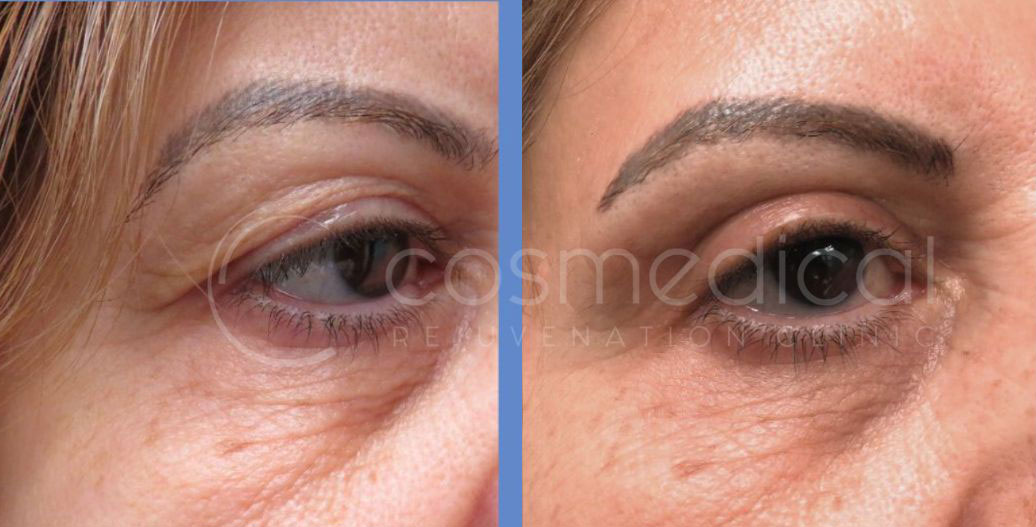Upper and Lower Blepharoplasty
What is eyelid surgery called? Technically, eyelid surgery is referred to as blepharoplasty. Blepharoplasty resolves aesthetic issues affecting the upper and lower eyelids. These issues are referred to as the following:
The technical term for redundant or lax eyelid skin and muscle is dermatochalasis. Dermatochalsis can affect both the upper and lower eyelids, and it is caused by a decrease in elasticity, thinning skin, and weakening of connective tissues.
Steatoblepharon is the technical term referring to the prominence of fat pads located in the eyelids.
Upper Blepharoplasty
Upper blepharoplasty, or upper eyelid surgery, is a procedure that involves removing or repositioning extra skin, orbital fat, and muscle tissue from the upper eyelid. This surgery significantly reduces the appearance of saggy or puffy upper eyelids, resulting in a more alert and youthful look.
A study in the Aesthetic Surgery Journal reported that upper blepharoplasty not only enhanced the aesthetic appearance of participants but also improved their overall quality of life. This improvement was primarily due to the correction of vision impairment caused by excess upper eyelid skin.
Upper blepharoplasty typically involves a small incision along the natural crease within the upper eyelid, allowing for the removal or repositioning of tissues.
Medical research supports the safety and effectiveness of upper blepharoplasty. The Journal of Plastic, Reconstructive & Aesthetic Surgery reports that most patients were satisfied with their results and experienced improved vision and appearance.
Lower Blepharoplasty
Lower blepharoplasty, or lower eyelid surgery, removes puffiness, undereye bags, and wrinkles.
As per a Journal of Plastic, Reconstructive & Aesthetic Surgery report, lower blepharoplasty resulted in high patient satisfaction rates. Many participants reported improvements in self-esteem and social interactions following the procedure.
Lower eyelid lifts typically involve an incision either within the lower eyelid or along the eyelash margin. Tissues are removed or repositioned through the incisions, which are then closed.
It's important to note that while lower blepharoplasty can dramatically improve the eye aesthetic, it cannot eliminate dark circles, fine lines around the eyes, or other signs of aging not directly related to the eyelids. Blepharoplasty is often performed with other rejuvenating procedures, namely facelifts and browlifts.
Blepharoplasty Complications
Like any surgical procedure, blepharoplasty carries its own set of potential complications. Common complications of blepharoplasty include infection, bleeding, scarring, dry eyes, difficulty closing eyes, or even vision loss. According to a study in the Journal of Plastic, Reconstructive & Aesthetic Surgery, complications occur in approximately 3.85% of blepharoplasty procedures, a relatively low rate compared to other surgeries.
Risks Associated with Blepharoplasty
While severe complications are rare, they can occur. Hematoma, a collection of blood, and seroma a collection of fluid, can develop post-surgery and may require further procedures. Aesthetic complications, such as asymmetry or dissatisfaction with the cosmetic outcome, occur in about 1% of cases.
The most severe complication, although very rare, is vision loss. This occurs in less than 0.04% of cases, often due to severe bleeding behind the eye, which can cause permanent damage.
Prevention and Management
Preventing complications starts with a thorough pre-operative evaluation to assess the patient's health and eye condition. Patients should be honest about their medical history and follow all pre- and post-operative instructions.
If complications occur, early detection is key. Minor issues like dry eyes can be managed with eye drops, while more severe complications may require additional treatments or surgeries. Regular follow-ups with the surgeon can ensure any complications are caught and managed promptly.
How much is eyelid surgery? How much does eyelid surgery cost? Blepharoplasty Cost In Toronto
If you're considering eyelid surgery in Canada, you're probably wondering about the cost. Let's break down the factors that influence the price and give you a general idea of what to expect.
1. Type of Surgery: There are different types of eyelid surgeries, which can affect the overall cost. Not only is cost based on whether the upper, lower or both eyelids are treated, surgical techniques are also considered.
2. Geographical Location: Major cities like Toronto or Vancouver tend to have higher prices compared to smaller towns simply because the cost of living is higher.
3. Facility Fees: The cost of the surgery can be affected by where it’s performed. Private clinics may charge more than hospitals, but they often provide a more personalized experience.
4. Anesthesia Fees: The type of anesthesia used (local or general) can influence the cost. General anesthesia, which requires an anesthesiologist, is more expensive.
5. Additional Costs: There may be additional costs for pre-surgery consultations, medical tests, post-surgery medications, and follow-up appointments.
How To Get Insurance To Pay For Eyelid Surgery
Cosmetic eyelid surgery isn't usually covered by health insurance. However, if the surgery is recommended to treat a medical condition, such as impaired vision caused by droopy eyelids, there may be some coverage. To get your procedure covered, first speak with your doctor.




